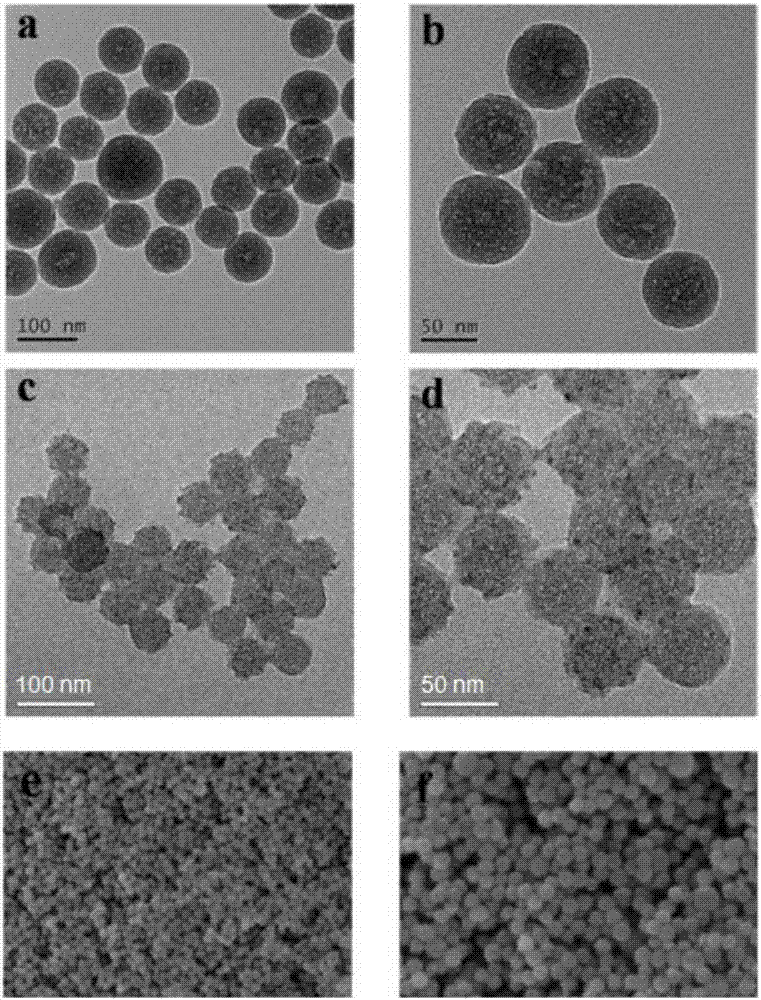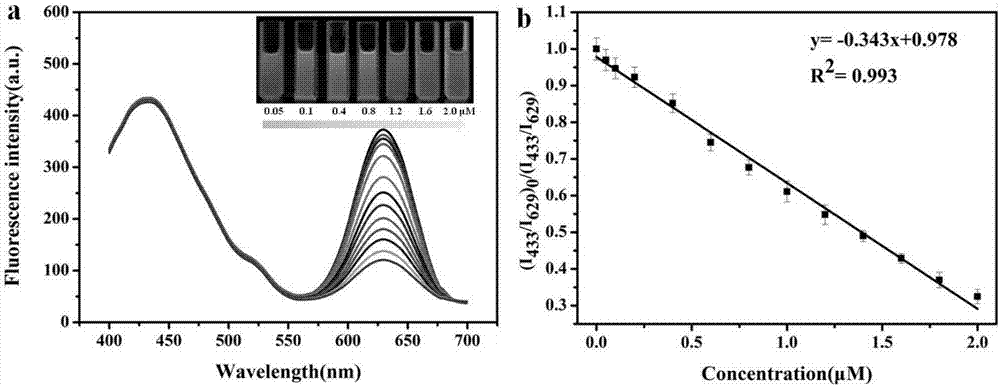Ratio fluorescence probe for detecting pyrogallic acid as well as preparation method and application
A ratiometric fluorescent probe and pyrogallic acid technology, applied in fluorescence/phosphorescence, measuring devices, and material analysis through optical means, can solve problems such as unconstructed pyrogallic acid ratiometric fluorescent probes, and achieve operational Effects for simplicity, good selectivity and visualization
- Summary
- Abstract
- Description
- Claims
- Application Information
AI Technical Summary
Problems solved by technology
Method used
Image
Examples
Embodiment 1
[0031] 1) Synthesis of blue fluorescent carbon quantum dots: dissolving citric acid and ammonia water in deionized water to form a precursor solution, subjecting the precursor solution to high temperature treatment, cooling down to room temperature and centrifuging, taking the supernatant for later use;
[0032] 2) Synthesis of silicon oxide nanoparticles embedding carbon quantum dots: Mix cyclohexane, TritonX-100, and n-hexanol, and stir for at least 1 hour to form a microemulsion; take step 1) and disperse the solution in the above microemulsion, and stir for at least 0.5 h Then, add ammonia water and TEOS, stir for 24h, then add APTES, continue to stir for 24h; centrifuge and wash the reaction solution to obtain silicon oxide nanoparticles embedding carbon quantum dots;
[0033] 3) Synthesis of red fluorescent glutathione modified cadmium telluride quantum dots: under nitrogen protection and ice bath conditions, tellurium powder and NaBH 4 Dissolve in deionized water, stir ...
Embodiment 2
[0042] In step 2), when adding step 1) gained solution, also add chitosan solution simultaneously, described step 1) The volume ratio of gained solution and chitosan solution is 5:1; Described chitosan solution is in 1% The mass volume fraction in acetic acid is 0.5%. All the other are consistent with embodiment 1.
experiment example 1
[0044] Pyrogallic acid detection:
[0045] Disperse the probe described in Example 1 in the buffer solution, take multiple sets of reaction test tubes, add appropriate volume of probe solution, pyrogallic acid solution and laccase of known concentration, mix well, and react for a period of time. The reaction solution was added to a quartz dish, and detected by fluorescence spectrophotometry (λex=365nm). Calculate the working curve according to the test results. Such as image 3 As shown, the response range of the probe to pyrogallic acid is 0.05-2 μM, and the linear coefficient of the detection result is 0.993.
[0046] For unknown samples, sample pretreatment is performed first to obtain pyrogallic acid solution of unknown concentration. Take the same volume of probe solution and laccase, add to the sample solution, mix well, and react for a period of time. The reaction solution was added to a quartz dish, and detected by fluorescence spectrophotometry (λex=365nm). Subst...
PUM
 Login to View More
Login to View More Abstract
Description
Claims
Application Information
 Login to View More
Login to View More - R&D
- Intellectual Property
- Life Sciences
- Materials
- Tech Scout
- Unparalleled Data Quality
- Higher Quality Content
- 60% Fewer Hallucinations
Browse by: Latest US Patents, China's latest patents, Technical Efficacy Thesaurus, Application Domain, Technology Topic, Popular Technical Reports.
© 2025 PatSnap. All rights reserved.Legal|Privacy policy|Modern Slavery Act Transparency Statement|Sitemap|About US| Contact US: help@patsnap.com



